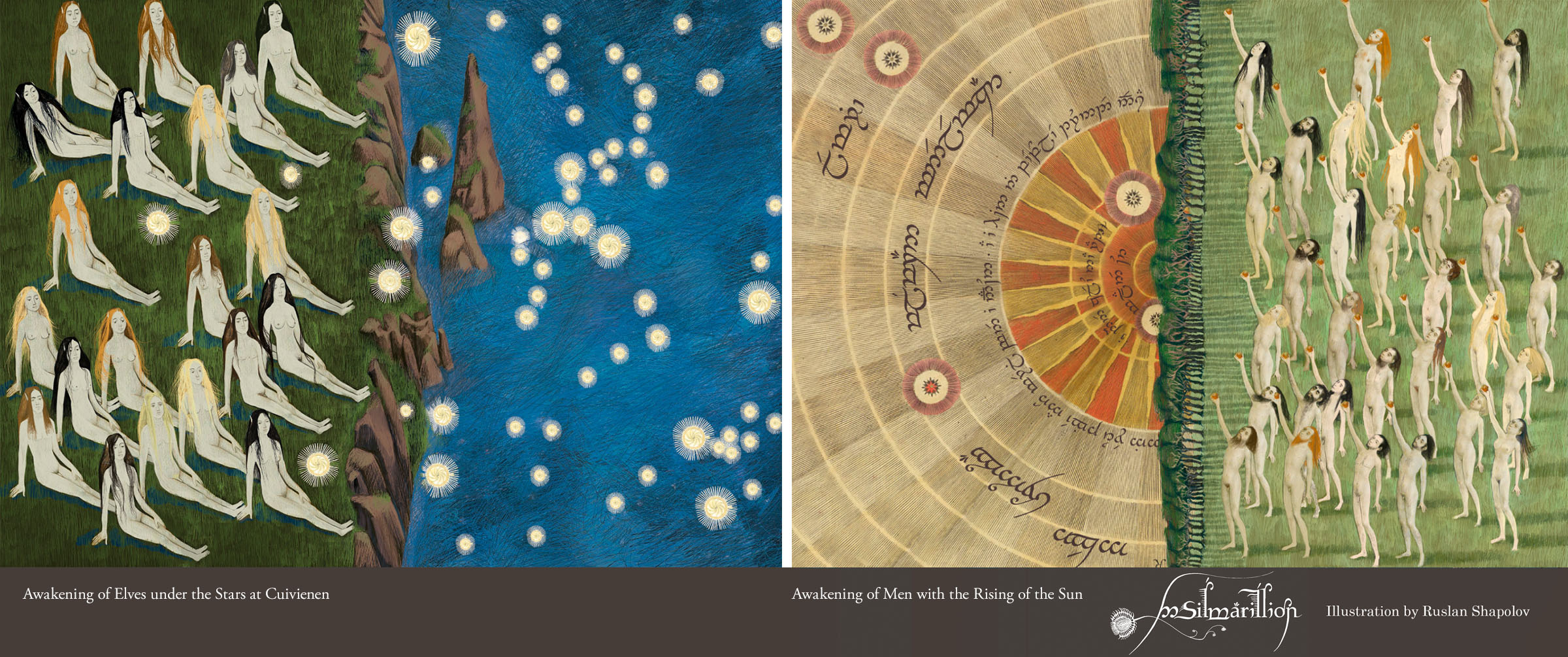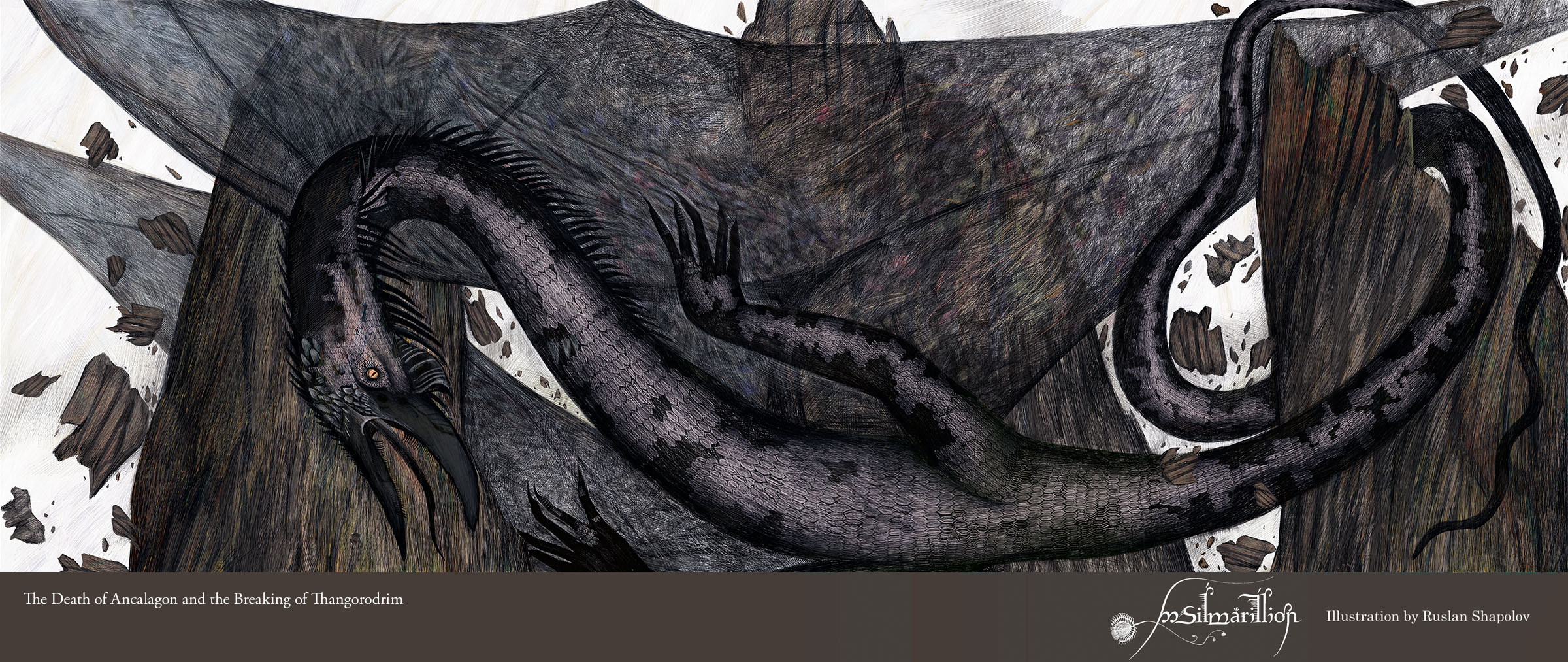Interview with artist Ruslan Shapolov by Anérea
Posted on 18 October 2023; updated on 28 October 2023
This article is part of the newsletter column Tolkien Fanartics.

In the space of a single year, Ukrainian artist Ruslan Shapolov undertook the creation of an astounding body of fanart: fully illustrating The Silmarillion with more than fifty colour and line art drawings, as well as designing the entire book’s layout, complete with intricately decorated initial caps and marginalia. For a printed book, he designed many of the full-page illustrations to be fold-out panoramas, with an elaborate cover and slip-case that appears to be a Silmaril wrapped in colourful dragon skin.
Featured recently in the final instalment of firstamazon’s biography of Túrin, Ruslan’s Silmarillion illustrations are an eclectic blend of romanticism and naive art, the flattened perspective and exaggerated scale of Byzantine art, and the decorative flourishes of art nouveau—with a uniquely organic vision of Elven architecture. They bring back memories of my childhood, where I spent hours wandering around within the imaginary worlds illustrated in some of my favourite books. Each time I come back to look at his illustrations I fall in love with them a little more, and want to know more about them and the thoughts and processes that lie behind them, so I was delighted when he agreed to be interviewed for Tolkien Fanartics.

Anyone who puts in this much care and dedication is clearly an avid fan! How did you discover Tolkien’s work, and The Silmarillion, and how did it affect you?
Thank you for appreciating my hard work! Yes I am a fan of Tolkien's world, he created a great work that I want to study and immerse myself in again and again. I was a kid when I first saw Peter Jackson's movie, The Lord of the Rings. I wanted to watch it over and over again, and then I started reading the books, starting with The Hobbit.
To be honest, when I was a teenager it was hard for me to understand and comprehend The Silmarillion. There are so many characters and events, but it gave me a sea of images of landscapes, castles, cities, trees, mountains, and dragons. The basic feeling was like looking at the world from a height as if you were on a huge playing field.
As for the book, The Lord of the Rings, I found it very atmospheric and clear for easy perception. I liked sometimes to close myself in a room for a few days and read it without stopping.
So you could say I grew up on these stories, it's a part of me.

What prompted you to start illustrating The Silmarillion? Did you have the idea of illustrating the entire book right from the beginning, or did you start with just one or two drawings and then the idea grew from there?
I have to say that I had my first attempts at illustration when I was fourteen years old. I remember then I drew a big picture, metre by metre, which depicted The Battle of Five Armies from the book The Hobbit. Then I made various other attempts. Later, at twenty-three years old, I had the idea to create my own illustrated book so that I could delve even deeper and understand it, study it. It was very interesting! I reread the chapters time after time, making up the world with my imagination to match Professor Tolkien's descriptions.
The style of your illustrations evoke a feeling of some of my favourite children’s book illustrations from the mid-twentieth century, and yet yours have a level of detail with a touch of whimsy that is utterly unique. Tell us about your influences and inspiration, and how your style developed.
The execution technique was inspired from mediaeval paintings, illustrations, and tapestry. I drew with thin pencil, stippling to show the velvet and hand labour of classical drawing. Naturally I was inspired by the famous illustrators Alan Lee, John Howe, Ted Naismith.



I cannot choose a favourite illustration of yours! Do you have a favourite scene (or scenes) that you particularly enjoyed illustrating and why? Which was the easiest and which was the most difficult to illustrate?
I started drawing from the concept of the architecture of Valinor. I thought about what kind of architecture it could be, something that clearly has natural features. Definitely it should be round on the foundation like a tent, as ancient houses used to be round. So I started thinking about marquees, inspired by nuts, acorns, flowers and other natural forms.
I also started thinking about the concept of the ships: they have two sails as it imitates the image of a swan. Overall the first illustration I finished was perhaps the awakening of the Elves by the lake, where I practised drawing the necessary strokes.
The last illustration was the creation of Arda. It was probably the most difficult one, to visualise the music and draw it. Not just draw the music, but the very same Ainur. I don't know why, but I was just inspired by the patterns on the wings of butterflies, and I thought, why not?



You have a Masters degree from Kharkiv State Academy of Design and Fine Arts, and now work as a professional digital artist. Is art something you’ve enjoyed since a young age? Please tell us a little about your studies and career.
Yes, I've really been involved in professional fine arts all my life. My parents are artists, and my studies have all had an impact.
This project was actually a Master's thesis at the Academy, but it went beyond the diploma, which no one had ever done before. I became one of the best graduates in the history of the Academy.
At the moment, I'm creating computer games as a concept artist and coming up with the stories. I would very much like to work on a big project in Tolkien's universe in the future, such as a movie, series, or game, as I love it so much.

There is a remarkable diversity of styles between that of your Silmarillion illustrations (as well as the lovely pen and ink drawings you made for the book Perfume) and the designs you create professionally, such as your character and game designs. Do you find both styles come naturally to you?
In fact, I treat each work as a separate universe, where I use my own expressive style to emphasise and convey the atmosphere.
For The Silmarillion, I thought I wanted to make a book that felt like it was from that universe, like it was drawn there.

What do you appreciate as being your biggest strength as an artist? And what helps you perform?
I think I am best at fantasy and imagination, although I am also good at painting and drawing. I am also quite industrious and a workaholic. I spend a lot of time each day creating illustrations, you could say almost all the time, but a walk in the fresh air helps to think too.

Do you have any advice for aspiring artists?
Take it and do it! If you have an idea, draw it, don't hesitate. The coolest ideas are those that are fresh, which you will show on canvas without remodelling.

Are there any individual illustrations you’d like to tell us more about, such as the creation process and concepts behind them?
Some of the illustrations I have are so wide, they are spread over several pages. With the Fall of Númenor, the event is so grandiose that it's just not possible to fit it into one book spread. I tried to show everything at once in three stages: the wave covers the city, the city under the water and ships on the foam of the wave, the few who were saved together with Isildur.

Would you like to share a little of your daily life with us? (The past year and a half in particular must have brought changes previously unimagined; has this influenced your creativity in any way?)
Unfortunately, lately I have in my country, Ukraine, war. It is not very inspiring for me to work, although sometimes I want to hide from all the news and sit to draw without thinking about anything.

If you could escape reality for a day with any Tolkien character, who would you choose to be with, and where would you go?
Actually I would like to communicate with Prof. Tolkien, to show illustrations, to ask about books. As for the magical world, I really want to visit Lothlórien to see Galadriel.


Conclusion
I cannot speak for Tolkien, but I suspect he might bemoan the reticence of publishers to risk the high cost of printing a book full of colour illustrations. I for one would love to page through a book with these illustrations printed large in rich colour, and very much hope that Ruslan Shapolov’s dream of publishing in one form or another becomes a reality.
Until then, I'll keep returning to his Tumblr to revisit Ruslan's vision of Arda. If you'd like to view more of his art, or get in touch with him, his portfolio and contact information is also on ArtStation.
(All images may be viewed larger by right-clicking on them to open in a new tab.)


Such an amazing project!…
Such an amazing project! Thank you for doing this interview; it is great to get a more coherent picture of this beautiful and original artwork.
Such an amazing project indeed!
Such an amazing project indeed! I've been really excited about this interview and delighted that you're appreciating his art and this peek at the person behind it. Thanks for letting us know.
Amazing artwork
Ruslan Shapolov's illustrations for The Silmarillion are so detailed, and epic. They truly embody the meaning of awesome.
A fantastic and very informative interview.